Inside Santiago cathedral
A number of old buildings fall into the category of having spectacular facades, but somewhat disappointing interiors. The cathedral at Santiago is definitely not one of them.
Most tourists enter the cathedral from the large "Obradoiro" square and climb the
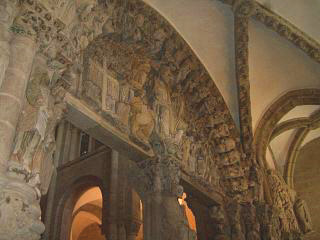 granite stairs, entering the building through its famous "Portico de la Gloria" archway. Coming into the cathedral through this opening has the decorative altar appearing at the cavernous chamber's opposite end. There is also an entrance through the northern facade of the cathedral situated in the "Azabacheria" plaza, which brings you into the building from the rear.
granite stairs, entering the building through its famous "Portico de la Gloria" archway. Coming into the cathedral through this opening has the decorative altar appearing at the cavernous chamber's opposite end. There is also an entrance through the northern facade of the cathedral situated in the "Azabacheria" plaza, which brings you into the building from the rear.
What you can see in the cathedral depends on whether or not you choose to buy a pass. If you just want a wonder around, then there is no charge and frankly most visitors will be more than satisfied with what they can see for free. You can explore the greater part of the cathedral's main areas and look in awe at the amazing vaulting, intricate stone carvings and elaborate
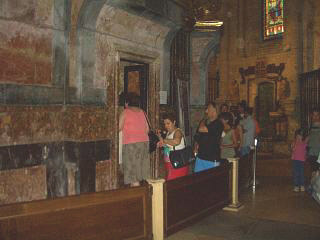 altar. You can also queue up to see the casket containing the remains of St.James, or join an even longer line of people wishing to walk around the back of the altar and perform the religious (some would say superstitious) act of kissing a Christian artefact found there. The artefact in question is a 13th century likeness of the apostle and the small alcove to its rear where the worhipers enter is called the the "little chamber". (The people in the photo to the left are queuing up to perform this ritual). These areas of Santiago's cathedral are chock-a-block with people and things only calm down when a service takes place and a level of dignity is returned to this ancient monument.
altar. You can also queue up to see the casket containing the remains of St.James, or join an even longer line of people wishing to walk around the back of the altar and perform the religious (some would say superstitious) act of kissing a Christian artefact found there. The artefact in question is a 13th century likeness of the apostle and the small alcove to its rear where the worhipers enter is called the the "little chamber". (The people in the photo to the left are queuing up to perform this ritual). These areas of Santiago's cathedral are chock-a-block with people and things only calm down when a service takes place and a level of dignity is returned to this ancient monument.
For those who want a more in depth and less people populated inspection of the cathedral's innards, purchasing the pass (or ticket) mentioned above is the ideal option. This pass gives you access to several levels of the cathedral including many museum exhibits, the basement crypt (which is far from impressive) and the multi-arched high level gallery which affords some spectacular views down to the main square and beyond. In all we thought the cost of this ticket (around 7 euros) excellent value and we spent over one and a half hours wondering around before the afternoon siesta brought our explorations to a halt and we were ushered out.
A bit more detail
The original church that occupied the spot where the cathedral now stands was conceived in the eleventh century and was constructed and enlarged over a period of a hundred years or more. The plan shape of the church was in the form of a cross and some parts of this original structure still remain.
The most eye catching element of the cathedral's interior is undoubtedly the magnificent
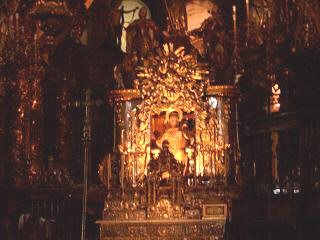 altar in the high chapel (the Capilla Mayor pictured below). This feature, which is a monument in its own right, includes a glistening thirteenth century statue of the seated saint James dressed in what is claimed to be a pilgrim's outfit. Above and to the sides of this sculpture are many more figurines, some of the apostle, others of Kings and still more of angels. There are also coats of arms and a decorative plinth on which some of these statues are perched. In all, the complete gold and silver plated structure is breath taking and the only down side is the difficulty in squeezing past the other tourists to get a good view of it.
altar in the high chapel (the Capilla Mayor pictured below). This feature, which is a monument in its own right, includes a glistening thirteenth century statue of the seated saint James dressed in what is claimed to be a pilgrim's outfit. Above and to the sides of this sculpture are many more figurines, some of the apostle, others of Kings and still more of angels. There are also coats of arms and a decorative plinth on which some of these statues are perched. In all, the complete gold and silver plated structure is breath taking and the only down side is the difficulty in squeezing past the other tourists to get a good view of it.
Architecturally there is a mix of styles within Santiago's cathedral, but the buildings large vaulted dome is gothic and dates from the fourteen hundreds. Huge columns support the gargantuan interior and act to split up the area into its various composite parts including chapels and the ambulatory.
The other famous features of the cathedral are the apostle's crypt and the
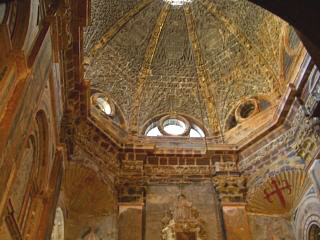 "Camarin", the later being a small compartment behind the altar where the pilgrims can kiss the head of St. James' statue (described previously). Visiting both these areas requires the joining of a queue which can be quite lengthy depending on the day and time. Above some vaulting in one of the cathedrals towers.
"Camarin", the later being a small compartment behind the altar where the pilgrims can kiss the head of St. James' statue (described previously). Visiting both these areas requires the joining of a queue which can be quite lengthy depending on the day and time. Above some vaulting in one of the cathedrals towers.
One other ritual, for which Santiago cathedral is especially famous, is the swinging of a massive incense burner down the central aisle of the cathedral during Mass. This incense burner is called a "botafumeiro" and it takes the muscles of several individuals pulling on a single rope to hoist and swing the botafumeiro along its path. Incense has long been a part of religious services of many denominations, but it is thought that the reason for this exaggerated method of spreading the incense may have something to do with masking the smell
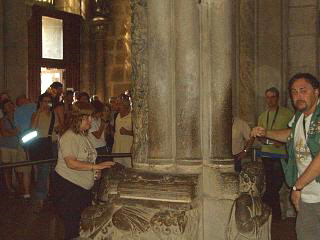 that must have filled the cathedral when it was full of pilgrims, many of whom would not have washed for several days.
that must have filled the cathedral when it was full of pilgrims, many of whom would not have washed for several days.
Left, this is the column just inside the Portico de la Gloria on which those of a
catholic persuasion touch their heads three times as part of a holy ritual. We hope that
those people pictured do not object to this photo been included on a public access
site and that these religious rituals have been described and illustrated in a dignified manner.
Follow this link to find out about Santiago cathedral's facade and external history.

